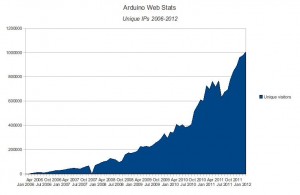New Forum Boards and Moderators
Today we welcome three new forum moderators as well as the Dutch (Nederlands) board and a new structure for the French boards. JO3RI and JANTJE are our new Dutch moderators and Nick Gammon becomes part of our Global Moderator’s list.
We are experiencing a huge increase in the traffic on the Arduino site. Most of it goes to the forum. We are happy to see this development in the community. Last month was the first time we reached over 1.000.000 unique IPs on our server and this month we will reach it again. Here a graph showing the development of the visits to the Arduino website:
We are now working in preparing the next generation of the website. It is going to take some months before you see anything coming out, I can only say it will be great 🙂 We want the Arduino site to be the best place for makers to meet up and share their projects … but it is going to demand a lot of effort to make it happen.
In the meanwhile we will keep on patching the server and we will make sure everything you guys are contributing with makes it to the next iteration of the system: forum messages, playground pages, and translations.

March 29th, 2012 at 16:53:08
That’s great! Any word of how the radioshack sales were during the past few months? Just a thought, maybe the forum visits and radioshack sales could be correlated? Microcenter.com is also selling arduino/compatible hardware now.
March 30th, 2012 at 07:56:04
Hej,
I don’t have the graphs with me but overall Arduino sales and server traffic are correlated. Obviously the fact Radioshack put Arduino on the shelves last Xmas affected the load for that particular vacation period.
April 10th, 2012 at 20:38:29
Hello,
I started a project on kickstarter that Arduino users may be interested in. Short story is that it is an Arduino based thing for end users that want to use electronics in a project, but don’t want to figure out how to get wifi working, and how to solder and how to…
Link to project is:
http://www.kickstarter.com/projects/694850905/the-ard-vark
It has wifi built in, controls up to 4 servos and 2 DC motors, temperature sensor and light sensor built in with ports to connect other things. I invented this because I was tired of having to spend 3 or 4 hours figuring out how to get wifi working and then make headers for servos and input sensors.
Thanks,
Kerwin
April 30th, 2012 at 19:06:43
I wonder what would take so that Third World countries could be part of this?
February 13th, 2019 at 08:39:23
Hi there i’m new to Arduino uno and i’m trying to write a program that will control a maglock from a webpage(Ethernet).When the button is clicked on webpage it should release the magnet for a few mins and return to lock mode again and if its open longer than that it should send a warning email.When program runs i want the pins to be off and not send through any voltage because its connected to a relay that’s arranged to be always on so the maglock will always be attached i just need the one command to run when the button is pressed to release the maglock for a few seconds and return to lock mode where pins should be off.
Please help i’ve been struggling with this for weeks now.
This is what i have so far:
#include
#include
// MAC address from Ethernet shield sticker under board
byte mac[] = { 0xDE, 0xAD, 0xBE, 0xEF, 0xFE, 0xED };
IPAddress ip(192 , 168 , 1 , 177); // IP address, may need to change depending on network
EthernetServer server(80); // create a server at port 80
String light = “OFF”;
void setup() {
Ethernet.begin(mac, ip);
server.begin();
Serial.begin(9600);
// initialize digital pin LED_BUILTIN as an output.
pinMode(LED_BUILTIN, OUTPUT);
}
// the loop function runs over and over again forever
void loop() {
digitalWrite(LED_BUILTIN, LOW); // turn the LED on (HIGH is the voltage level)
delay(1000000); // wait for a second
digitalWrite(LED_BUILTIN, LOW); // turn the LED off by making the voltage LOW
delay(1000000);
EthernetClient client = server.available(); // try to get client
digitalWrite(LED_BUILTIN, LOW);
if (client) {
boolean currentLineIsBlank = true;
String test = “”;
digitalWrite(LED_BUILTIN, LOW);
while (client.connected()) {
digitalWrite(LED_BUILTIN, LOW);
if (client.available()) {
digitalWrite(LED_BUILTIN, LOW);
char c = client.read();
Serial.write(c);
test.concat(c);
int position = test.indexOf(“LED=”);
if (test.substring(position) == “LED=ON”){
digitalWrite(LED_BUILTIN, HIGH);
delay(2000);
light = “OFF”;
}
if (c == ‘\n’ && currentLineIsBlank) {
// send a standard http response header
client.println(“HTTP/1.1 200 OK”);
client.println(“Content-Type: text/html”);
client.println(“Connection: close”);
client.println();
// send web page
client.println(“”);
client.println(“”);
client.println(“”);
client.println(“Arduino Web Page”);
client.println(“”);
client.println(“”);
client.println(“Hello from Arduino!”);
client.println(“A web page from the Arduino server”);
client.println(“”);
client.println(“ON”);
client.println(“”);
client.println(“Switch is “);
client.print(light);
client.println(“”);
client.println(“”);
break;
}
if (c == ‘\n’) {
currentLineIsBlank = true;
}
else if (c != ‘\r’) {
currentLineIsBlank = false;
}
}
}
}
}